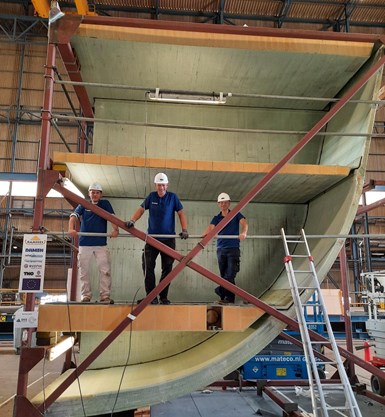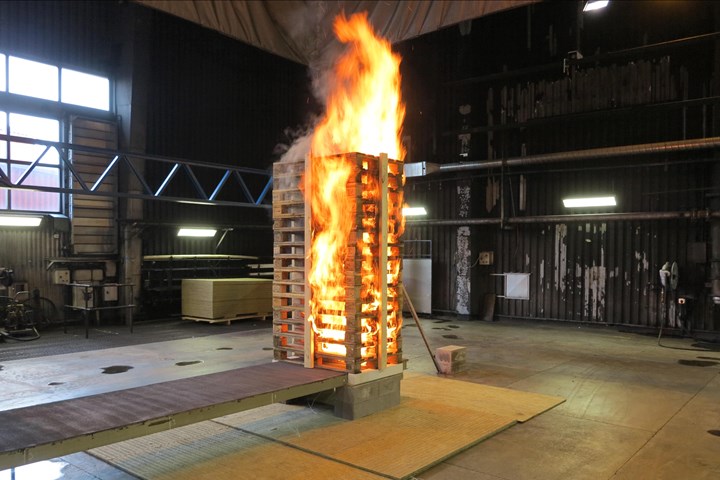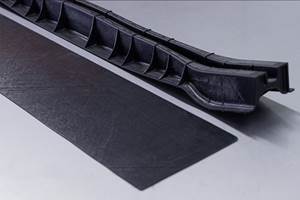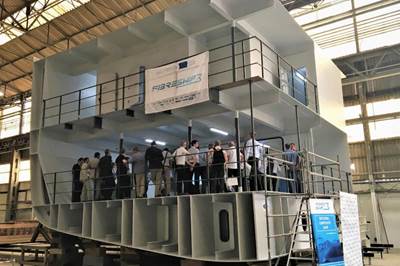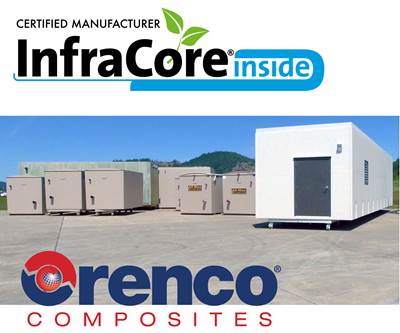InfraCore develops composite helideck for 85-meter seagoing patrol vessel
Nominated for the JEC Innovation Awards 2022, the FRP deck has undergone rigorous impact and hydrocarbon fire tests, proving that it is robust enough to resist a helicopter crash.
InfraCore Co. B.V. (Rotterdam, Netherlands) has developed a composite helideck for an 85-meter seagoing patrol vessel. The project, which was carried out in cooperation with the EU RAMSSES (Realization and Demonstration of Advanced Material Solutions for Sustainable and Efficient Ships) project and Damen (Netherlands) shipyards, was nominated for the JEC Innovation Awards 2022 in the Maritime Transportation and Shipbuilding category.
By applying InfraCore technology, the company says it was able to design and manufacture a helideck that is robust enough to resist a helicopter crash. In a conventional sandwich structure, the core is structural which means a heavy, expensive core is required, InfraCore notes. Using its solution, however, which consists of skins connected through the webs, the construction can be thinner and thus more lightweight and cost efficient; in this case, the core is not structural. It is also said to be more robust and safe as potential cracks can only grow for a limited length in the structure.
FRP helideck was part of a larger demonstrator also comprising the ship hull, two bulkheads, two additional decks and joints to connect all panels. Photo Credit, all images: InfraCore Co. B.V.
The helideck underwent both impact tests and a hydrocarbon fire test (shown in the video above), both comparable to a helicopter crash. The impact test was carried out by releasing a 1,500-kilogram (3,307-pound) pendulum from a 1.5-meter height. Real-time impact monitoring was performed using acoustic emissions (AE) equipment to determine where damage occurred. These tests were carried out three times to validate results, InfraCore says, which determined that damage was localized, meaning the structure was robust enough to remain intact and functional in the case of an emergency.
During the hydrocarbon fire test, the helideck was exposed to fire for more than one hour via a stack of heavy burning pallets that were placed on top of the helideck. A layer of fireproof coating had been applied to the helideck, the only modification made compared to a normal InfraCore panel. The helideck remained intact after the fire was extinguished, successfully meating maritime safety fire regulations.
The helideck, InfraCore says, was part of a larger demonstrator construction, consisting of a ship hull, two bulkheads, three decks (including the helideck) and joints to connect all panels. The design of the joints is said to have been one of the most challenging parts. Due to the curvature of the hull and the different purpose of the individual decks, both the load direction and magnitude is different on each panel. This meant that each joint had to be different. Additionally, the bottom deck was thicker than the rest to keep out water. The joints were tested (up to failure) and also lived up to the strict requirements.
“With these groundbreaking results, InfraCore technology is on its way to disrupt the shipbuilding industry,” Simon de Jong, founder of InfraCore, says. “We are excited to see what the future holds for using more FRP [fiber-reinforced polymers] in shipbuilding and help to make this industry more sustainable.”
The helideck and joints are currently in the process for the approval in principal (AIP). The AIP is carried out by testing, inspection and certification company Bureau Veritas (Neuilly-sur-Seine, France). InfraCore recently received an AIP for its rudder flap which is part of a 19000 teu (twenty-foot equivalent unit) container ship rudder. The rudder flap can reportedly improve hydrodynamic performance, lifetime and reduce maintenance costs.
InfraCore will be exhibiting its helideck, joints, rudder flpa and more at JEC in hall 6, booth M74.
Related Content
ASCEND program update: Designing next-gen, high-rate auto and aerospace composites
GKN Aerospace, McLaren Automotive and U.K.-based partners share goals and progress aiming at high-rate, Industry 4.0-enabled, sustainable materials and processes.
Read MorePlant tour: BeSpline/Addcomp, Sherbrooke, QC, Canada
Composites automation specialist increases access to next-gen technologies, including novel AFP systems and unique 3D parts using adaptive molds.
Read MoreCarbon fiber, bionic design achieve peak performance in race-ready production vehicle
Porsche worked with Action Composites to design and manufacture an innovative carbon fiber safety cage option to lightweight one of its series race vehicles, built in a one-shot compression molding process.
Read MoreOptimized approach to predict delamination failure in CFRTP structures
ARRK Engineering and Mitsui Chemicals improved delamination prediction accuracy to help optimize absorbed energy/failure load for an overmolded TAFNEX CF/PP UD tape bumper beam.
Read MoreRead Next
Removing barriers to lightweighting ships with composites
EU consortia propel large demonstrators, new technology and affordable certification.
Read MoreOrenco and FiberCore sign license agreement for InfraCore technology in U.S.
Collaboration matches delamination-resistant technology with large FRP structures expertise for new applications and U.S. market growth.
Read MorePlant tour: Daher Shap’in TechCenter and composites production plant, Saint-Aignan-de-Grandlieu, France
Co-located R&D and production advance OOA thermosets, thermoplastics, welding, recycling and digital technologies for faster processing and certification of lighter, more sustainable composites.
Read More







